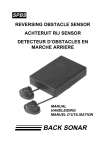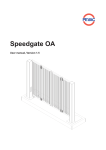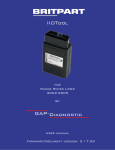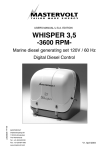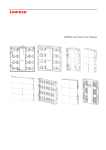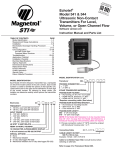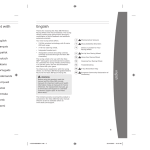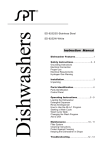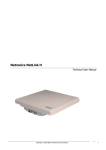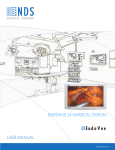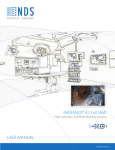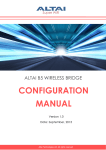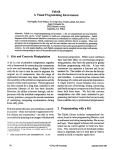Download Tyre-Killer TK
Transcript
Tyre-Killer TK User manual, Version 1.4 ® Pevac 04-2002 Nothing in this manual may be reproduced and/or published by means of print, photocopy, microfilm or any other means whatsoever, without the prior permission of Pevac B.V. This also applies for the associated illustrations. en - 2 Tyre-Killer TK 04-2002 Pevac Tyre-Killer TK The Pevac Tyre-Killer TK is a special dynamic anti-terrorism blockade which is provided with specially hardened teeth. The Tyre-Killer TK is a high quality product for the highest degree of protection. In case of a collision, the special teeth penetrate and totally destroy both the tyres and the wheel rims of the unauthorised vehicle. The teeth can rise out of the road surface or sink back into it in only a few seconds. Declaration of agreement The Tyre-Killer TK is accompanied by a manufacturer’s declaration. With this, the product complies with the New Approach guidelines, which guarantees optimal safety. However, it’s forbidden for people to come close tot the TyreKiller TK, when raised or when operated. The manufacturer is never responsible for damage or personal injurie. The Tyre-Killer TK is hydraulically driven. The hydraulic drive is electrically operated. There are a great number of possibilities for operation, from simple, manual operation to advanced entry control systems. 04-2002 Tyre-Killer TK en - 3 TABLE OF CONTENTS 1 USE OF THE INSTALLATION MANUAL 1.1 1.2 2 Related documentation 7 Use according to destination 7 15 8.1 8.2 8.2.1 15 15 15 8.2.2 2.1 2.2 8 8 8.3 8.4 8.5 8.6 8.6.1 Safety and health risks Safety precautions of the Tyre-Killer TK Recommended environmental safety provisions Safety precautions and maintenance GUARANTEE 3.1 Liability 8 9 4.1 4.2 4.3 4.4 4.4.1 4.4.2 11 11 12 12 12 12 OPERATION AND USE 6 PERIODIC INSPECTION BY OWN PERSONAL 7 STORAGE AND TRANSPORT 7.1 7.2 7.3 8.7 8.8 8.9 8.9.1 10 11 Technical data Main components Product identification Principles of operation Tyre-Killer TK Mechanical Lock (option) 8.6.2 10 MACHINE DESCRIPTION 5 en - 4 INSTALLATION 8 2.4 4 8 SAFETY 2.3 3 7 8.9.2 8.10 9 13 13 14 Storage of the Tyre-Killer TK 14 Transport of the Tyre14 Killer TK Transport of the concrete 14 foundation Tyre-Killer TK 15 15 16 16 16 16 16 17 17 17 17 17 17 HYDRAULIC SYSTEM 18 9.1 9.2 18 18 9.3 10 Installation preparation Installation conditions Hydraulic drive unit in installation cabinet Hydraulic drive unit in a separate room Materials to be used Pit in asphalt or concrete Pit in cobbled road Placing the concrete base Fixing the concrete base on site Fixing the pre-fabricated concrete base Sealing the pit Placing the Tyre-Killer TK Fitting the jacket sleeves For use of an installation cabinet For use in a mechanical room Installation of hoses and cables Hydraulic drive unit Hydraulic drive unit, type HC-ML Operation with the hand pump 21 ELECTRICAL INSTALLATION 21 10.1 10.2 10.3 21 21 22 10.4 Hydraulic drive unit Placing the Tyre-Killer TK Cable diagram TyreKiller TK Electrical diagram TyreKiller TK 23 04-2002 11 CONNECTION OF THE TYREKILLER TK 24 11.1 11.2 24 24 11.3 11.3.1 11.3.2 11.3.3 11.3.4 12 13 14 04-2002 Electrical connections Placing and connecting the controller box Hydraulic connections Bleeding air from the hydraulic hoses of the lift Bleeding air from the hydraulic hoses of the Mechanical Lock Hydraulic connections Tyre-Killer TK Hydraulic connections Mechanical Lock (option) 24 24 24 25 25 COMMISSIONING 26 12.1 12.2 12.3 12.4 12.5 Function for switches Preventing access Permitting access Checking the operation Final assembly 26 27 27 27 27 GENERAL INSPECTION AND MAINTENANCE 28 13.1 28 Service intervals THE TYRE-KILLER TK AND THE ENVIRONMENT 28 14.1 28 End of life span Tyre-Killer TK en - 5 This page is empty en - 6 Tyre-Killer TK 04-2002 1 USE OF THE INSTALLATION MANUAL This manual is intended for persons who are responsible for installing, operating and maintaining the Tyre-Killer TK. This manual describes how the Tyre-Killer TK can be safely installed, used and maintained. Read the manual completely before installing or using the Tyre-Killer TK. Keep this manual in the control room. In this manual the following pictograms and symbols are used: Warning Danger of injury to operator or bystanders, or danger of major damage to the Tyre-Killer TK or to other objects. Follow the instructions carefully. Danger Life threatening danger or danger of serious injury. Follow the instructions carefully. Note Tip to make work easier. Environment Remark regarding the environmental impact of the Tyre-Killer TK in operation and of the Tyre-Killer TK should be disposed of. • Action Actions to be taken. 04-2002 This manual has been drafted with the utmost care. Pevac B.V. is not liable for damage that occurs as a result of any inaccuracies in this manual. We request that you inform us, as a matter of urgency, of any inaccuracies you may find. 1.1 Related documentation As well as this manual for the Tyre-Killer TK, there are also the following documents: - Maintenance book Tyre-Killer TK. - Log card. - Hydraulic drawings. - Controller drawings. 1.2 Use according to destination The Tyre-Killer TK may NOT be used on a public road. In terrain’s where the Tyre-Killer TK has been installed, a maximum speed of 30 km/hour must be observed. The Tyre-Killer TK may not be used for moped riders, cyclists, motorcycle riders and pedestrians. The Tyre-Killer TK can be used in the following situations: Security of amongst others: - Military bases; - Banks; - Financial institutions; - Embassies; - High security industrial area’s. Any other or extended use does not comply with the intended use. Use and install the Tyre-Killer TK only when it is in technically perfect condition. Tyre-Killer TK en - 7 2 SAFETY In this chapter, the safety aspects of the Pevac Tyre-Killer TK are discussed. Read this chapter thoroughly before use of the Tyre-Killer TK. 2.3 Recommended environmental safety provisions 2.1 Safety and health risk The Tyre-Killer TK has been safely constructed. At each installation in a certain environment, new risks can occur that can be different for each installation. The customer must carefully assess beforehand what risks can occur after the installation. In general the following risks can be distinguished: Collision with the Tyre-Killer TK due to bad visibility; Collision due to excessive speed; Possible injury to moped riders, cyclists, motorcycle riders and pedestrians because they are too close to the TyreKiller TK. During the design of the Tyre-Killer TK, safety precautions were taken to reduce these risks as much as possible. By taking account of the above risks and by following the safety regulations, these risks are limited even more. 2.2 Safety precautions of the Tyre-Killer TK To make the use of the Tyre-Killer TK as safe as possible, the following safety measures have been taken: A clear colour choice ensures good visi bility of the Tyre-Killer TK; Accumulation of dirt can reduce the visi bility of the Tyre-Killer TK. The accumu lation of dirt will be limited due to the smooth surface of the Tyre-Killer TK; To prevent slipperiness of the Tyre-Killer TK in the sunken condition, as much as possible, the top plate is fitted with an anti-slip surface. en - 8 Tyre-Killer TK Warning Environmental measures must be taken for the safe use of the TyreKiller TK. The necessary measures will be different for each situation. In general the following measures will contribute to decreasing risks for road users. Danger The environment must be adapted in such a way that a high speed (higher than 30 km/hour) is hard to reach, for example by bumps in the road surface, an S-curve (with unobstructed view) in the road and maximum speed signs. Danger In order to ensure the safety of moped riders, cyclists, motorcycle riders and pedestrians, they must not be permitted in the vicinity of the Tyre-Killer TK. Establishing a danger zone with the help of traffic signs, text signs, pictograms, road markings and the physical separation of traffic flows can facilitate this. Warning Traffic lights, warning boards, and lighting should be placed in the vicinity to insure good visibility of the Tyre-Killer TK. Danger If a traffic light is to be utilised, the green light may only be given if the obstacle is in the lowest position: this indicates that the passage is completely unobstructed. The traffic light must change to red several seconds before the Tyre-Killer TK is raised in order to give road users sufficient time to stop. The traffic light must remain red while the TyreKiller TK is moving and while it is in the highest position. 04-2002 Warning It is forbidden to stop or to park above the Tyre-Killer TK. Traffic signs can also indicate this. 2.4 Safety precautions and maintenance Note It is advisable to make recordings with a security camera in the vicinity of the Tyre-Killer TK. This has the advantage of providing a record of a possible collision and allowing a determination of the possible cause. Furthermore, sabotage can be witnessed and recorded. • • • • • Warning The obstacle must not rise if vehicles are above the Tyre-Killer TK. To this end, detection systems such as detection loops in the road surface, photocells, or cameras can be used. Check the Tyre-Killer TK on every first working day of the week for proper func tioning. Check the visibility of the Tyre-Killer TK every first working day. Remove dirt and replace the striping if it is damaged. Carry out maintenance in accordance with the specifications in the maintenance and repair logbook. During installation and maintenance work, the drive must be disengaged. The Tyre-Killer TK can only be operated by personnel who are adequately trained and familiar with the operation. Warning Fault detection can be used. In the event of a fault, the traffic light must change to red and remain red. Additionally, in that case, a signal must be sent to the central control room. 04-2002 Tyre-Killer TK en - 9 3 GUARANTEE - Guarantee is given according to the conditions stated in the “Conditions of the Metal Union”. Pevac BV, however, gives a guarantee for a period of 24 months instead of 6 months, as stated in 14.1 of the conditions of the metal union. A copy of these conditions can be obtained from Pevac BV. The Tyre-Killer TK has been manufactured with the utmost care. Therefore, Pevac BV gives the initial user a guarantee for 24 months, taken from the invoice date. The guarantee implies that Pevac BV makes replacement parts available, free of charge, for all parts that show any shortcomings, within the term mentioned, due to imperfections of the material or manufacture. Excluded from guarantee are all parts that should be replaced according to the maintenance schedule. - The repair or replacement of parts during the period of guarantee does not result in the extension of this term. Replaced parts become property of Pevac BV. The guarantee concerns the replacement of defective parts, exclusive of installation, at the discretion of Pevac BV. Pevac BV explicitly rejects all further claims for compensation of damage, of any nature. The guarantee does not apply for faults that have occurred due to injudicious, incorrect or careless handling, incorrect use, incorrect connection or connection by unqualified parties. The guarantee expires if: Unauthorised parties have carried out repairs or maintenance to the installa tion; The installation was not used in accordance with the normal intended use or was used under abnormal circumstan ces; en - 10 - It cannot be shown that the installation was inspected by a qualified installer or service organisation in accordance with the maintenance schedule; The complaint is not immediately repor ted to a qualified installer or service organisation; Repairs are carried out without the prior permission of Pevac BV; Parts are replaced without prior permission from Pevac BV; Original parts are not used during repair; The damage was caused by use other than mentioned in § 1.2 “Use according to intended purpose”; Claims do not take place within eight days after the complaint was discovered or reasonably should have been disco vered. If necessary, Pevac BV can require that the parts are shipped postage-paid to Pevac BV. Postage-paid return is made if the repair was carried out under guarantee. Excluded from guarantee is all damage that has occurred to the Tyre-Killer TK by persons, vehicles, or adjacent moveable or immovable property. 3.1 Liability Pevac BV accepts no liability for damage or physical injury that occurs due to: Not following the instructions in this manual; Carelessness during the use, main tenance, repositioning, installing, dis mantling or repair of the Tyre-Killer TK; Use that is not in compliance with the intended purpose. Tyre-Killer TK 04-2002 4 MACHINE DESCRIPTION The Tyre-Killer TK consists of a steel frame that is mounted in a pre-fabricated concrete foundation. In the concrete foundation are the connections for the conduits for cables and hoses and the drain tubes. These connections are on the hinged side of the Tyre-Killer TK. The obstacle with teeth and the cylinders are attached to the frame. An obstacle is the blocking element of the TyreKiller TK. The obstacle is attached to the frame by hinges. In the highest position, the obstacle has a height of 280 mm above the surface. The Tyre-Killer TK has two hydraulic cylinders for raising and lowering and one hydraulic cylinder for locking the obstacle in the raised position. The following cylinders are used. Hydraulic cylinders: Name Cylinder type Volume Volume bottom piston side side Lifting 30/20 - 250 mm 354 cc 197 cc Locking 25/15 - 40 mm 19.6 cc 15.1 cc 4.2 Main components 4.1 Technical data Sizes: Type Height Width Length TK 2000 450 mm 830 mm 2100 mm TK 2500 450 mm 830 mm 2600 mm TK 3000 450 mm 830 mm 3100 mm TK 3500 450 mm 830 mm 3600 mm TK 4000 450 mm 830 mm 4100 mm TK 4500 450 mm 830 mm 4600 mm TK 5000 450 mm 830 mm 5100 mm TK 5500 450 mm 830 mm 5600 mm TK 6000 450 mm 830 mm 6100 mm TK 6500 450 mm 830 mm 6600 mm TK 7000 450 mm 830 mm 7100 mm TK 7500 450 mm 830 mm 7600 mm TK 8000 450 mm 830 mm 8100 mm The height of the teeth is 280 mm above the surface in its upper position. The Tyre-Killer TK consists of the following components: 1. Top plate Obstacle. 2. Teeth. 3. Obstacle. 4. Frame. 5. Top plate Frame. Weights: Type Weight (incl. obstacle) TK 2000 575 kg TK 2500 700 kg TK 3000 825 kg TK 3500 950 kg TK 4000 1075 kg TK 4500 1200 kg TK 5000 1325 kg TK 5500 1450 kg TK 6000 1575 kg TK 6500 1750 kg TK 7000 1875 kg TK 7500 2000 kg TK 8000 2150 kg 04-2002 Tyre-Killer TK en - 11 4.3 Product identification 4.4.2 Mechanical Lock (option) The type plate (fig. 4.3) contains the following data: The Tyre-Killer TK can be equipped with a Mechanical Lock (ML). This ML is a mechanical lock that locks the obstacle on the Tyre-Killer TK in the highest position. In this way, the TyreKiller TK cannot be lowered even if the hydraulic pressure is completely diminished, in the case of sabotage for instance. The mechanical lock is operated with a hydraulic cylinder. The position of the mechanical lock is detected through the use of two proximity switches. 1. Type number 2. Serial number 3. Year of construction 4. Weight 4.4 Principles of operation 4.4.1 Tyre-Killer TK According to the “quickly up, quickly down” principle, a steel obstacle can be moved that provides a dynamic blockade of the terrain. This obstacle is moved upward with hydraulic cylinders to block a passage and moved downward to make the passage free. The teeth of the Tyre-Killer TK are pointing towards the attack side. There are two proximity switches mounted in the frame of the Tyre-Killer TK. With the help of these switches, the two end positions of the obstacle can be determined or a fault detected. The Tyre-Killer TK can be, depending on the controller used, manually or automatically operated. en - 12 Tyre-Killer TK 04-2002 5 OPERATION AND USE Depending on the manner in which the TyreKiller TK is installed, a separate user manual for operation may be applicable. See the user manual included with the controller system. 04-2002 6 PERIODIC INSPECTION BY OWN PERSONAL To guarantee the safety and the proper functioning of the Tyre-Killer TK maintenance is necessary. Every week the following actions must be taken: • Check the Tyre-Killer TK for correct functioning. • Check the visibility of the Tyre-Killer TK. • Remove dirt from the Tyre-Killer TK. • Check that no water remains in the TyreKiller TK. Tyre-Killer TK en - 13 7 STORAGE AND TRANSPORT - Warning Ensure that for lifting work, the strength of the hoisting belts or chains can handle the weight to be hoisted. Warning Ensure that the Tyre-Killer TK hangs completely horizontally and in balance during hoisting. 7.1 Storage of the Tyre-Killer TK When storing the Tyre-Killer TK, attention should be paid to the following points: Place the Tyre-Killer TK on a flat and stable surface. Protect the Tyre-Killer TK from dirt and moisture. Prevent damage to the zinc coating by placing the Tyre-Killer TK on a wooden surface. 7.2 Transport of the Tyre-Killer TK Note For the weight of the Tyre-Killer TK, see the technical specifications, § 4.1. - Hoist the Tyre-Killer TK with four hoisting belts or chains on the truck. Place the Tyre-Killer TK horizontally on the loading platform, so that the obstacle is on the top. Fasten the Tyre-Killer TK firmly on the truck, so that it cannot slide in any direc tion during transportation. The same directions apply for unloading as for loading. 7.3 Transport of the concrete foundation For the weight of the concrete foundation, see the technical specifications, § 4.1. Sequence of working during transport of the concrete foundation: - - Warning Prevent damage to the powder coating and the zinc layer during transport. Screw the 4 crane hooks or hoisting loops into the screw sleeves that are poured in the bottom of the concrete foundation. Install the hoisting belts or chains on the crane hooks or hoisting loops. Hoist the concrete foundation onto the loading platform Make sure that the foundation is secu rely attached to the loading platform. Warning Position the Tyre-Killer TK on a wooden surface. Order of working when transporting the TyreKiller TK: Screw the 4 hoisting eyes into the inten ded locations The same guidelines apply to unloading as to loading. en - 14 Tyre-Killer TK 04-2002 8 INSTALLATION 8.1 Installation preparation Note The hydraulic drive unit must be installed within a radius of 15 m from the Tyre-Killer TK. For successful installation you should prepare yourself as follows: Danger During the installation (and also during other work on the Tyre-Killer TK), the power supply of the installation must always be switched off. 8.2 Installation conditions Warning The Tyre-Killer TK can only be installed, inspected, maintained and/or repaired by personnel who are qualified by Pevac BV. At the place of installation, the necessary control cables and hoses must be present. Depending on the road surface in which the Tyre-Killer TK must be installed, it will be necessary, in accordance with the installation, to make a pit and a trench in the road surface in: - Asphalt hardening (see § 8.4), or - Cobbled road (see § 8.5). 8.2.1 Hydraulic drive unit in installation cabinet 1. Tyre-Killer TK 2. Installation cabinet with controller and hydraulic drive 3. Jacket sleeve for feed-through of the cables and hoses 8.2.2 Hydraulic drive unit in a separate room If the hydraulic drive unit is to be installed in a separate mechanical room, together with the controller, a jacket sleeve for the drive unit and the controller must be laid from this area to the Tyre-Killer TK. 8.3 Materials to be used For positioning the Tyre-Killer TK, the following equipment / tools are necessary: Crane truck. Hoisting belts or chains. Diamond saw (only for asphalt or con crete hardening). Gravel. Concrete. PVC jacket sleeve with connectors (ø 100 mm or ø 125 mm) for the hydrau lic hoses and the electrical cable. Pull cord, to pull the cables and hoses through the jacket sleeve. PVC drain tube with sleeves (ø 100 mm or ø 125 mm) for the drainage of rainwater (if connection to the sewer is possible). Electrical connection (in the control room) with main switch. PUR foam (only to be used if the hydraulic drive unit is to be placed in a separate mechanical room). The hydraulic drive unit can be placed, together with the controls, in an installation cabinet. A jacket sleeve for the cables and hoses must be laid from the installation cabinet to the TyreKiller TK. 04-2002 Tyre-Killer TK en - 15 8.4 Pit in asphalt or concrete • • Mark off the location on the road surface where the Tyre-Killer TK should be posi tioned and where the jacket sleeve must be placed. The sizes of the pit and the groove for the jacket sleeve are given in the following tables. Cut into the asphalt a few centimetres with a diamond saw. The length of the groove depends on the distance between the pit and the control room. The maximum distance is 15 m. 8.5 Pit in cobbled road • • • Mark off the location on the road surface where the Tyre-Killer TK should be posi tioned and where the jacket sleeve must be placed. Remove the cobbles at that location. Dig the pit for the Tyre-Killer TK and the groove for the jacket sleeve sufficiently deep. 8.6 Placing the concrete base 8.6.1 Fixing the concrete base on site • • • Dig away the asphalt in front of the TyreKiller TK as well as in front of the jacket sleeve. Dig the pit for the Tyre-Killer TK and the groove for the jacket sleeve sufficiently deep. Pit sizes: Type Depth Width Length TK 2000 650 - 700 mm 1500 mm 2800 mm TK 2500 650 - 700 mm 1500 mm 3300 mm TK 3000 650 - 700 mm 1500 mm 3800 mm TK 3500 650 - 700 mm 1500 mm 4300 mm TK 4000 650 - 700 mm 1500 mm 4800 mm TK 4500 650 - 700 mm 1500 mm 5300 mm TK 5000 650 - 700 mm 1500 mm 5800 mm TK 5500 650 - 700 mm 1500 mm 6300 mm TK 6000 650 - 700 mm 1500 mm 6800 mm TK 6500 650 - 700 mm 1500 mm 7300 mm TK 7000 650 - 700 mm 1500 mm 7800 mm TK 7500 650 - 700 mm 1500 mm 8300 mm TK 8000 650 - 700 mm 1500 mm 8800 mm • • • • • Make a wooden base as shown on the drawing of the concrete base. Make sure that the wooden base is completely levelled and that the top is levelled with the road surface. Put reinforcement in the wooden base as shown on the drawing of the concrete base. Make the proper openings for the bolds and put the inserts in place. Make the proper openings for connecting the conduits and drainage pipes, and put the connectors for the conduit in place. Fill the wooden base with concrete according the specifications of the con crete base construction company. If the concrete is completely hardened, remove the wooden shelf from the pit and clean the pit. Grove sizes: Depth Width 700 - 800 mm 250 mm en - 16 Tyre-Killer TK 04-2002 8.6.2 Fixing a pre-fabricated concrete base Warning Ensure that for lifting work, the strength of the hoisting belts or chains can handle the weight to be hoisted. • • Flatten out the bottom of the pit. Position the concrete base in the pit so that: - It is completely levelled. - The top rim is levelled with the road surface. 8.9 Fitting the jacket sleeves 8.9.1 For use of an installation cabinet • • • • 8.7 Sealing the pit • • - Fill up the space surrounding the con crete base with sand and seal it pro perly. Fill up the remaining space with glassfibre reinforced concrete, in accordance with the concrete supplier’s specificati ons. In the case of a cobblestone road, cover the opening above the concrete with previously removed cobblestones. Note Put the cobblestones in the concrete. Do not use sand under the cobblestones. 8.9.2 For use in a mechanical room • • • • 8.8 Placing the Tyre-Killer TK • • Position the Tyre-Killer TK, inside the concrete base on the hoisting gin, in the pit so that: - It is completely level. - The top rim is level with the road surface. Remove the hoisting eyes from the TyreKiller TK. Create a feed-through from the mecha nical room with a diameter of 125 mm, at an angle of 45°, so that this ends up on the outside, below the surface. Put the supplied jacket sleeve in the groove, pass one end in the connector that’s in the centre of the concrete base and the other end in the wall feedthrough, to a position about 10 cm under the floor surface. Feed the pull cord through the jacket sleeve. Fit the drain tube for rain water drainage and connect it to the sewer at the other end (if appropriate). 8.10 Installation of hoses and cables • • Warning The attack side (this is the teeth side of the Tyre-Killer TK) must be positioned on the correct side. Warning Do not use 90º bends in the corners of the jacket sleeve for the feedthrough of the hydraulic hoses. 04-2002 Put the jacket sleeve in the groove and connect one end to the connector that’s inserted in the centre of the concrete base. Connect the other end of the conduit in the wall feed-through in the base of the installation cabinet. Feed the pull cord through the jacket sleeve. Fit the drain tube for rain water drainage and connect it to the sewer at the other end (if appropriate). Tyre-Killer TK Remove the cover plates (deck plates) of the Tyre-Killer TK. Pull the hydraulic hoses and the electri cal cable through the jacket sleeve. Use the pull cord in the jacket sleeve for this purpose. - Be certain that the hydraulic hoses in the Tyre-Killer TK are sufficiently long. - Be certain that the cable in the TyreKiller is sufficiently long. Note Be certain that there are no kinks in the hydraulic hoses or the cable. en - 17 9 HYDRAULIC SYSTEM 9.1 Hydraulic drive unit A hydraulic drive unit is necessary to drive the Tyre-Killer TK. For good, reliable operation of the Tyre-Killer TK, it is necessary to use a hydraulic unit that meets the following minimum specifications: Minimum working pressure Maximum working pressure Pump capacity Tank capacity 70 bar 110 bar 7.8 cc 4 litre For operation of the Tyre-Killer TK, the unit must be equipped with electrically operated hydraulic valves for: 1. Raising and lowering the obstacle; 2. Extension and retraction of the mechani cal lock. For operation of the hydraulic drive unit see the manufacturer’s directions. Hydraulic unit HC-078 ML: Pump capacity Voltage Motor power Rise and fall time 7.8 cc/ 380 V 2.2 kW 1.9 sec revolution (3 phase) 4/3 valve (back and forth): Flow rate Voltage Power Maximum working pressure 50 l/min 230 VAC 28 W 250 bar 9.2 Hydraulic drive unit, type HC-ML The diagram on the next page shows the hydraulic system of the unit HC-ML. In the drawing, component locations are indicated with labels: 1. In the Tyre-Killer TK. 2. In the hydraulic drive unit. Some of the components shown in the hydraulic diagram for the HC-ML unit are mounted on the hydraulic drive unit. The following table shows which components are located on the hydraulic drive unit. Obstacle down: If the controller gives the command ‘obstacle down’, the gear pump (H) begins to turn, through which the hydraulic oil becomes pressurized. As result, the 4/3 valve (T) of the mechanical lock is operated, through which the obstacle is unlocked. If the lock is moved, the sensor detects this condition. Thereafter, the 4/3 valve for the mechanical lock is deactivated. Then the 4/3 valve for the lift cylinders is operated, through which the top side (or rod side) of the cylinders (Q) comes under pressure and the cylinders are driven downward. As result, the return valve is brought under pressure, through which it is opened, so that the oil under the cylinders can flow back to the reservoir. Once the obstacle has moved completely downward, a sensor detects this condition and the 4/3 valve for the lift cylinders switches the gear pump off. The 4/3 valve for the lift cylinders returns to the rest position. Obstacle up: If the controller gives the command ‘obstacle up’, the gear pump (H) begins to turn, through which the hydraulic oil comes under pressure. As result, the 4/3 valve (K) is operated, through which the under side (or bottom side) of the cylinders (Q) comes under pressure, and the obstacle is raised. The oil on the top side of the cylinders flows freely back to the reservoir. Once the obstacle has moved upward, a sensor detects this condition and switches the 4/3 valve off. Thereafter, the 4/3 valve for the mechanical lock is activated, through which the corresponding cylinder (Y) comes under pressure and the lock extends. A sensor detects this condition and switches the gear pump off. The 4/3 valve for the mechanical lock is deactivated and returns to the rest position. The hydraulic return valve (M) prevents the obstacle from sinking downward through its own weight or the leakage of oil. With the hydraulic drive unit, type HC-ML, the obstacle can be lowered and raised, and the obstacle is locked in the highest position with the mechanical lock. en - 18 Tyre-Killer TK 04-2002 Position Diagram A B C D E F G H I J K L M N O P Q R S T U V W X Y Valve spool K1 K2 S1 S2 04-2002 Unit A B C D E G K L M N O P R S T U V W X - Position Description Oil tank Tank level indicator with level switch Fill cap with filter Manometer with manometer valve Pressure switch Suction filter Electric motor (3 phase) Gear pump Over-pressure valve (set at 100 bar) Return valve Manual control for 4/3 valve 4/3 valve (electrically operated / spring return) Return valve (hydraulically operated) Throttle needle Quick coupler: male Quick coupler: female Hydraulic cylinder Hand pump Manual control for 4/3 valve 4/3 valve (electrically operated / spring return) Throttle needle Throttle needle Quick coupler: female Quick coupler: male Hydraulic cylinder Associatedwith Hydraulic pump drive Lift cylinders Lift cylinders Lift cylinders Lift cylinders Lift cylinders Lift cylinders Hoisting obstacle Mechanical lock Mechanical lock Mechanical lock Mechanical lock Mechanical lock Mechanical lock Mechanical lock Function Obstacle up Obstacle down Mechanical lock Unlocked Mechanical lock Locked Tyre-Killer TK en - 19 Throttle needle functions: Position Description N Regulating lowering speed of obstacle U Regulating unlocking speed V Regulating locking speed en - 20 Tyre-Killer TK Notes: • The rise speed of the obstacle should be approximately equal to the lowering speed. • The locking speed should be approximately equal to the unlocking speed. 04-2002 9.3 Operation with the hand pump: In the event of mains power failure, the operation of the Tyre-Killer TK can be entirely performed with the hand pump, in which case both 4/3 valves must be manually operated. The location of the hand pump on the hydraulic drive unit is shown in fig. 9.6. Obstacle down: 1. Set the 4/3 valve for the unlocking of the mechanical lock in the correct position. 2. Pressurise the oil with the hand pump until the obstacle is unlocked. 3. Return the 4/3 valve to the rest position (stop operating). 4. Set the 4/3 valve for the lowering of the obstacle in the correct position. 5. Pressurise the oil with the hand pump until the obstacle is lowered. 6. Return the 4/3 valve to the rest position (stop operating). Obstacle up: 1. Set the 4/3 valve for the raising of the obstacle in the correct position. 2. Pressurise the oil with the hand pump until the obstacle is raised. 3. Return the 4/3 valve to the rest position (stop operating). 4. Manually set the 4/3 valve for the locking of the obstacle in the correct position. 5. Pressurise the oil with the hand pump until the obstacle is locked. 6. Return the 4/3 valve to the rest position (stop operating). 10 ELECTRICAL INSTALLATION The Tyre-Killer TK is hydraulically driven. The hydraulic drive is electrically operated. 10.1 Hydraulic drive unit The hydraulic drive unit consists of the following electrical components: • Electric motor (3 phase) • Level switch • 4/3 valve for lift cylinders • 4/3 valve for mechanical locking (option) • Pressure switch 10.2 Placing Tyre-Killer TK The figure below shows a standard situation in which a Tyre-Killer TK can be put into service. In this situation, the Tyre-Killer TK is suitable for two-way traffic. Traffic lights are also used in this situation. The installation can, in most situations, be adapted as desired. Pos. Description Function A. Open detection loop. Automatic ride-out. B. Driveway. C. Safety detection loop. D. Tyre-Killer TK E. Traffic light Warning if the Tyre-Killer TK is raised: Ride-through is not possi ble! F. Safety detection loop. Automatic closing of the passage. G. Installation cabinet Control of the Tyre-Killer TK. with controller and hydraulic drive unit. H. Push-button console. Automatic closing of the passage. Operation of the Tyre-Killer TK. Note: If the hydraulic unit is installed in a mechanical room with the controllers, an installation cabinet (G) is not used. 04-2002 Tyre-Killer TK en - 21 10.3 Cable diagram Tyre-Killer TK The figure shows the standard cabling diagram for the Tyre-Killer TK installation. The table below shows the cables that are used. Cables and hoses for Tyre-Killer TK controller: Pos. Cable type From To 1. Power cable – armoured, with tinned copper ground wire, 5 conductors, 2.5 mm2 (12 AWG) Power supply Controller 2. Signal cable – armoured and shielded, 5 twisted pairs, 0.8 mm2 (18 AWG) Controller 3. Hydraulic hose 3/8” Hydraulic unit Tyre-Killer TK Obstacle up Hydraulic hose 3/8” Hydraulic unit Tyre-Killer TK Obstacle down Hydraulic hose 3/8” Hydraulic unit Tyre-Killer TK Obstacle: unlock Hydraulic hose 3/8” Hydraulic unit Tyre-Killer TK Obstacle: lock Tyre-Killer TK Approach switches (4x) Signal cable, armoured and shielded, 3 twisted pairs, 0.8 mm2 (18 AWG) Function 3 phase = neutral + ground Push-button cabinet Controller Operation 4. Power cable – armoured, with tinned copper ground wire, 3 conductors, 1.5 mm2 (14 AWG) Controller Traffic light Red / green 5. Power cable – armoured, with tinned copper ground wire, 3 conductors, 1.5 mm2 (14 AWG) Controller Traffic light Red / green 6. Signal cable – armoured and shielded, 1 twisted pair, 0.8 mm2 (18 AWG) Controller Detection loop Closedsafetydetectionloop 7. Signal cable – armoured and shielded, 1 twisted pair, 0.8 mm2 (18 AWG) Controller Detection loop Closedsafetydetectionloop 8. Signal cable – armoured and shielded, 1 twisted pair, 0.8 mm2 (18 AWG) Controller Detection loop Auto exit detection loop en - 22 Tyre-Killer TK 04-2002 10.4 Electrical diagram Tyre-Killer TK The drawing below shows the electrical diagram of the Tyre-Killer TK with Mechanical Lock. Limit switches in the Tyre-Killer TK: Code Function A Limit switch Down. B Limit switch Up. C Limit switch Unlocked. D Limit switch Locked. Wire colour coding: Code Wire colour BU Blue BN Brown BK Black WH White 04-2002 Tyre-Killer TK en - 23 11 CONNECTION OF THE TYRE-KILLER TK This chapter describes how the Tyre-Killer TK should be connected electrically and hydraulically. 11.1 Electrical connections • Connect the controller cable to connection strip ‘X1’ of the Tyre-Killer TK accor ding to the table below. Thereafter, check the connections carefully. Note For air bleeding, see also the user manual for the hydraulic drive unit. • Function X1.1 Feed voltage +24 VDC X1.2 Ground X1.3 Obstacle down (Contact proximity switch Down) X1.7 Obstacleup(Contactproximityswitch Up) X1.11 ObstacleUnlocked(Contactproximity switch Unlocked) X1.15 ObstacleLocked(Contactproximity switch Locked) 11.2 Placing and connecting the controller box The placement and connection of the controllers and the push button panel depends on the chosen installation and the control. The installation thereof is given in the accompanying documentation. 11.3 Hydraulic connections Danger • During connection of the hydraulic hoses, the hoses MUST NOT be under pressure. • The electrical mains power must be switched off. Warning When working with hydraulic systems be extremely clean: sand and other contaminants can lead to failures and excessive wear of the system. en - 24 11.3.1 Bleeding air from the hydraulic hoses of the lift • Electrical connections: Terminal Warning Ensure that the oil tank is always full. Connect the hydraulic hoses of the lift (in the Tyre-Killer TK) to one another. Connect the outlets of the hydraulic drive unit together. Careful The hydraulic hoses supplied by Pevac are already filled with hydraulic oil. For this reason fasten the hoses well, so that no oil can escape from the hoses, which would cause difficulty in the bleeding of air. • • • • Open the lift valve. Let the pump turn for approximately 10 minutes so that all the air is forced out of the hoses. Stop the pump and set the power off. Loosen the hoses of the Tyre-Killer TK from one another. - In order to detach the hoses, the ring of the quick-coupling must be retracted. 11.3.2 Bleeding air from the hydraulic hoses of the mechanical lock Perform this procedure now for the hydraulic hoses of the mechanical lock: • Attach the ends of the hoses (in the Tyre-Killer TK) together. • Connect the outlets of the hydraulic drive unit together. • Open the valve for the mechanical lock. • Let the pump turn for approximately 10 minutes so that all the air is forced out of the hoses. • Stop the pump and set the power off. • Loosen the hoses of the Tyre-Killer TK from one another. - In order to detach the hoses, the ring of the quick-coupling must be retracted. Tyre-Killer TK 04-2002 11.3.3 Hydraulic connections Tyre-Killer TK If the hydraulic hoses are free of air, the TyreKiller TK can be connected as follows: • Connect the hoses to the quickconnec tors on the T-pieces in the Tyre-Killer TK. • Loosen the swivel couplings on the top of the cylinders (as a rule, it is sufficient to loosen the couplings two turns). Careful The screw threads in the hydraulic cylinders must not be damaged! • • • • Let the obstacle rise to remove all of the air from the cylinders. By preference, use the hand pump (if present) to do this. Re-tighten the swivel couplings on the top of the cylinders. Allow the obstacle to fall. Check the oil level once again. Connection of the mechanical lock in the Tyre-Killer TK: Pos. Connection type Function A. Male Lock B. Female Unlock Connections for the Tyre-Killer TK: Pos. Connection type A. Male Obstacle up Function B. Female Obstacle down 11.3.4 Hydraulic connections mechanical lock (option) If the Tyre-Killer TK is connected, see § 11.2.2, the mechanical lock can be connected as follows: • Connect the hoses to the quick-connec tors mounted in the middle section of the Tyre-Killer TK. • Let the mechanical lock retract and then extend. • Check the oil level. 04-2002 Tyre-Killer TK en - 25 12 COMMISSIONING Danger Before the Tyre-Killer TK is tested: - There can be no cars on or in the vicinity of the Tyre-Killer TK; - The Tyre-Killer TK must be cleared of obstacles, such as materials that have been used for the assembly; - Personnel must be out of the vici nity of the Tyre-Killer TK. The operation/functioning of the Tyre-killer TK is as follows: 12.1 Function for switches In the following description, the functions of the valves and proximity switches refer to their functions. The following names are used: Type of detector Proximity switch Valve Name Function Limit switch down Detects lowest position of the obstacle Limit switch up Detects uppermost position of the obstacle Limit switch unlocked Detects the “unlocked” position of the mechanical lock Limit switch locked Detects the “locked” position of the mechanical lock Valve down Lowering of the obstacle Valve up Pressure switch en - 26 Raising of the obstacle Valve unlock Unlocking of the obstacle Valve lock Locking of the obstacle Pressure switch Detect maximum hydraulic pressure in the hydraulic system caused by reaching a mechanical endpoint or blocking of the obstacle Tyre-Killer TK 04-2002 • 12.2 Preventing access • • • • • • • Push the button: “Obstacle up”: The motor of the hydraulic drive unit isengagedandthevalveUPisopened. This allows pressure into the hydraulic cylinders that causes the obstacle to rise. If the obstacle is in the highest position, limit switch UP detects this condition. If the obstacle is prevented from moving higher, the pressure in the hydraulic system rises and the pressure switch is activated. A combination of limit switch UP and the pressure switch ensures that valve UP closes. The valve LOCK will now be activated, causing the cylinder of the mechanical lock to extend (lock the obstacle). If the cylinder of the mechanical lock is completely extended, the limit switch LOCKED detects this condition. A com bination of limit switch LOCKED and the pressure switch ensures that valve LOCK closes. The valve LOCK returns to the rest posi tion and the motor is switched off. The entrance is now blocked. • • • 04-2002 The passage is now clear. Note: For the specific operation and the customer adapted controller panel, see the separate user manual for the customer adapted Tyre-Killer TK. Note: The operation of the Tyre-Killer TK is the same as the hydraulic diagram. 12.4 Checking the operation • • • • 12.3 Permitting access Push the button: “Obstacle down”: The motor of the hydraulic drive unit is engaged and the valve UP is briefly opened. This causes the obstacle to move completely upward allowing the mechanical lock to slide. The valve UP is closed and the valve UNLOCK is opened. This causes pres sure in the hydraulic cylinder that causes the mechanical lock to retract. If the mechanical lock is completely retracted, the limit switch UNLOCKED detects this condition. The valve UNLOCKED is now closed and the valve DOWN is opened. This allows pressure into the hydraulic cylinders that causes the obstacle to lower. If the obstacle is in the lowest position, limitswitchDOWN detectsthiscondi tion. A combination of the limit switch and the pressure switch ensure that the contact is broken, causing the valve DOWN to return to the rest position and the motor to be switched off. Check all hydraulic connections for leaks: - During movement of the obstacle; - When the Tyre-Killer TK is up; - When the Tyre-Killer TK is down. Check if the proximity switches detect in the correct position. Check if all signals of the electronic system function. Check that the Tyre-Killer TK is functio ning properly after installation. 12.5 Final assembly • • • Fill the connection cabinet in the TyreKiller with removable, flexible epoxy resin (3M GELLA 4441 or equivalent). Fit the Tyre-Killer TK cover plates. Lock the bolts with Loctite 270. Fill up the wall feed-through with PUR foam. Note: This is only appropriate is the hydraulic unit is installed in a separate room and not in an installation cabinet. The Tyre-Killer TK is now ready for use. Tyre-Killer TK en - 27 13 GENERAL INSPECTION AND MAINTENANCE 14 THE TYRE-KILLER TK AND THE ENVIRONMENT Warning When working on the Tyre-Killer TK, disconnect the mains power! Warning When working on the Tyre-Killer TK, close off the hydraulic pressure. To guarantee the safety and the proper functioning of the Tyre-Killer TK, maintenance by Pevac B.V. qualified personnel is necessary. Note See the Pevac B.V. maintenance book for the first maintenance. Through the use of biodegradable hydraulic oil, the environmental impact can be reduced. Take care, nonetheless, that in the case of leakage the oil cannot enter the environment directly. The use of an oil-leak pan in the installation cabinet can prevent this from occurring. The installed hydraulic drive is equipped with an electronic level detector. This allows early detection of any possible leakage so that measures can be taken in a timely manner. In addition, the hydraulic tank is provided with a sight glass. This permits checking of the oil level. 14.1 End of life span 13.1 Service intervals The Pevac B.V. Tyre-Killer TK can have a technical life span of 15 years under normal circumstances, with normal use and good maintenance. For the first time: A month after installation. After that: Three months after installation. Environment At the end of the life span the TyreKiller TK should be disposed of as follows. Consequently every: Six months. Work to be carried out: General visual check. Cleaning the Tyre-Killer TK and the mechanism. Lubrication of the cylinder eyes. Checking the attachment of bolts and nuts, specifically those of turning ele ments. Checking the hinges of the obstacle for play and, as necessary, replacing the plastic coating. Updating the Pevac B.V. log card. On this card, the corrective measures should also be recorded. If the log card is full, please send it to Pevac B.V. in Zevenhuizen. You will then receive a new log card by return mail. en - 28 Part Manner of processing Frame Scrap Obstacle Scrap Drive Revision Hydraulic oil Chemical waste Plastic parts Container for plastic Electrical components Special recycling companies Remains Tyre-Killer TK Scrap 04-2002




























